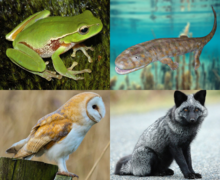| Stegocephali | |
|---|---|

| |
| Examples of stegocephalians (clockwise from top left): Litoria phyllochroa, Acanthostega gunnari, Vulpes vulpes, and Tyto alba | |
| Scientific classification | |
| Domain: | Eukaryota |
| Kingdom: | Animalia |
| Phylum: | Chordata |
| Clade: | Sarcopterygii |
| Clade: | Tetrapodomorpha |
| Clade: | Elpistostegalia |
| Clade: | Stegocephali Cope, 1868 |
| Subgroups | |
|
See text. | |
Stegocephali (often spelled Stegocephalia, from Greek στεγοκεφαλια, lit. "roofed head") is a clade of vertebrate animals containing all fully limbed tetrapodomorphs. It is equivalent to a broad definition of the superclass Tetrapoda: under this broad definition, the term "tetrapod" applies to any animal descended from the first vertebrate with four limbs each with digits in the extremity (pentadactyly), rather than fins of their sarcopterygian relatives.
Stegocephalians include both the modern lineage of limbed vertebrates (the crown group tetrapods, including modern amphibians, reptiles, birds and mammals) as well as a portion of the stem group, the earliest limbed tetrapodomorphs such as Ichthyostega and Acanthostega, which evolved in the Devonian period long before the origin of the crown group. Many paleontologists prefer a stricter definition of Tetrapoda which applies solely to the crown group, excluding earlier types of limbed tetrapodomorphs. Stegocephali was re-established to replace the broad definition of Tetrapoda, resolving the usage of two conflicting definitions in discussions of tetrapod evolution.
Stegocephali was coined in 1868 by the American paleontologist Edward Drinker Cope, who used it as a general category of prehistoric amphibians. This name was in reference to the skull form of many early tetrapods, with a low, solid shape combining numerous strongly-textured dermal bones.[1] In its original usage, the term quickly became obsolete. In 1998, Canadian paleontologist Michel Laurin repopularized the term and provided a formal phylogenetic definition as a monophyletic clade containing both crown-group and stem-group tetrapods. Laurin's Stegocephali is roughly defined as including all vertebrates closer to modern tetrapods than to Panderichthys. This definition was intended to include taxa with digits rather than fins, except where secondarily lost.[2][3] Another definition, published in Phylonyms, defines the group as including all taxa closer to Eryops than to Tiktaalik, Panderichthys, or Eusthenopteron.[4] The discovery of the Zachelmie trackways in 2010 suggests that stegocephalians possibly emerged 395 Ma or earlier.[5]
- ^ Cope E. D. 1868. Synopsis of the extinct Batrachia of North America. Proceedings of the Academy of Natural Sciences of Philadelphia: pp 208–221
- ^ Cite error: The named reference
:0was invoked but never defined (see the help page). - ^ Laurin, M; Soler-Gijón, R (May 2001). "The oldest stegocephalian from the Iberian peninsula: evidence that temnospondyls were euryhaline". Comptes Rendus de l'Académie des Sciences, Série III. 324 (5): 495–501. doi:10.1016/s0764-4469(01)01318-x. PMID 11411292.
- ^ Queiroz, Kevin de; Cantino, Philip D.; Gauthier, Jacques A. (2020). "Stegocephali E. D. Cope 1868 [M. Laurin], converted clade name". In De Queiroz, Kevin; Cantino, Philip; Gauthier, Jacques (eds.). Phylonyms: A Companion to the PhyloCode (1st ed.). Boca Raton: CRC Press. doi:10.1201/9780429446276. ISBN 9780429446276. S2CID 242704712.
- ^ Niedźwiedzki, Grzegorz; Szrek, Piotr; Narkiewicz, Katarzyna; Narkiewicz, Marek; Ahlberg, Per E. (January 7, 2010). "Tetrapod trackways from the early Middle Devonian period of Poland". Nature. 463 (7277): 43–48. Bibcode:2010Natur.463...43N. doi:10.1038/nature08623. ISSN 1476-4687. PMID 20054388. S2CID 4428903.